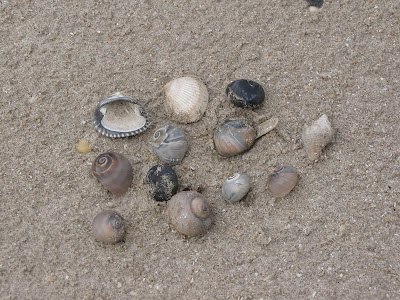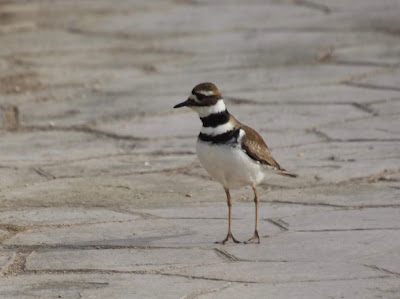It is impossible to do justice to Texas in the time we had. We only visited two places properly, but did a lot of driving across this huge state. At least we were there in the Spring, and there were many wildflowers in bloom along the sides of the road.
From New Orleans we stayed close to Louisiana's Gulf Coast, and drove along the beach road for part of the way.
A small portion of the beach.
There were lots of shells. This is a very small collection of them.
We had to cross one river by ferry. The terminal was thick with Laughing Gulls, but we didn't hear so much as a snigger.
Our first Texas destination was the Anahuac National Wildlife Refuge, a wetland which promised to host lots of interesting birds.
Birds there were in plenty, although the Everglades had more. Photographically it wasn't a major success, though. It was an overcast day and most of the birds were too far away for a really satisfying image.
A Common Gallinule, very similar to the European Moorhen.
A Roseate Spoonbill in flight.
A pair of Northern Shovelers.
The bird in the foreground is clearly a Black-necked Stilt. The one behind is probably a Willet, but there are several very similar sandpipers.
A Boat-tailed Grackle. They are very common in the South.
We don't know why this is called a Fulvous Whistling-duck. There were scores of them at Anahuac and, in spite of their common name, they were all silent!
Another Killdeer. They seem to be everywhere.
A Blue-winged Teal.
The blue of the wing is obvious in flight, as this pair shows even when obscured by some reeds.
There were also several ibises. The Glossy Ibis and the White-faced Ibis are, of course, virtually indistinguishable in their breeding plumage unless you get a good, close look at the face. One has a grey 'mask' with a thin, light blue border and the other has a dull red 'mask' with a thin white border. Easy if you have one in your hand, but at 100 metres in dull light … Our least worst picture suggests a grey 'mask' with a white border. Arrgh. The Glossy has yellow legs and the White-faced has reddish legs, but the birds we saw were so far away they appeared to have black legs. Based on one field guide's distribution map only the White-faced is found in Texas, but the other one says the Glossy is “rare but annual in Texas.” And anyway we were only just outside Louisiana.
There were plenty of colourful flowers along the route towards our next destination, Big Bend National Park.
The Texas Bluebonnet. This is the state's official flower and grows in large numbers along many of the roads we travelled. Gardeners will probably recognise it as a member of the lupin family. Trivial factoid: Americans call lupins lupines.
One of several “Paintbrush” flowers.
Another Paintbrush, probably. We haven't identified the species.
Bluebonnets and Paintbrushes flourishing by the roadside.
This is … tip of our tongues. We'll remember in a minute.
Unidentified, pretty, mauve flowers.
A kind of thistle.
As we got nearer Big Bend the vegetation had to cope with much drier conditions.
A big, prickly bush.
Those are BIG spines ...
... with very small, red fruits in hard-to-get-at places.






















No comments:
Post a Comment